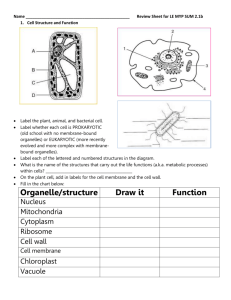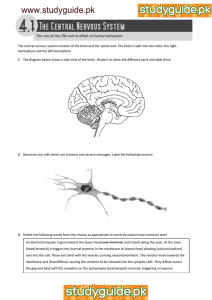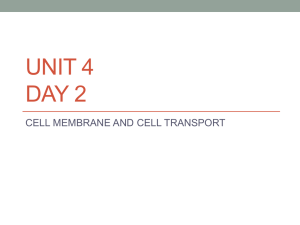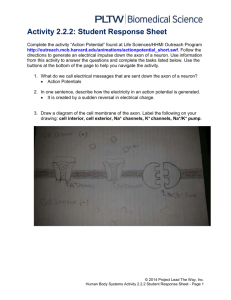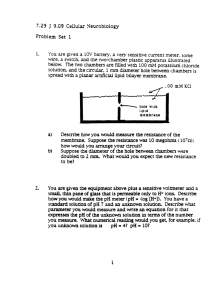Document 13541315
advertisement
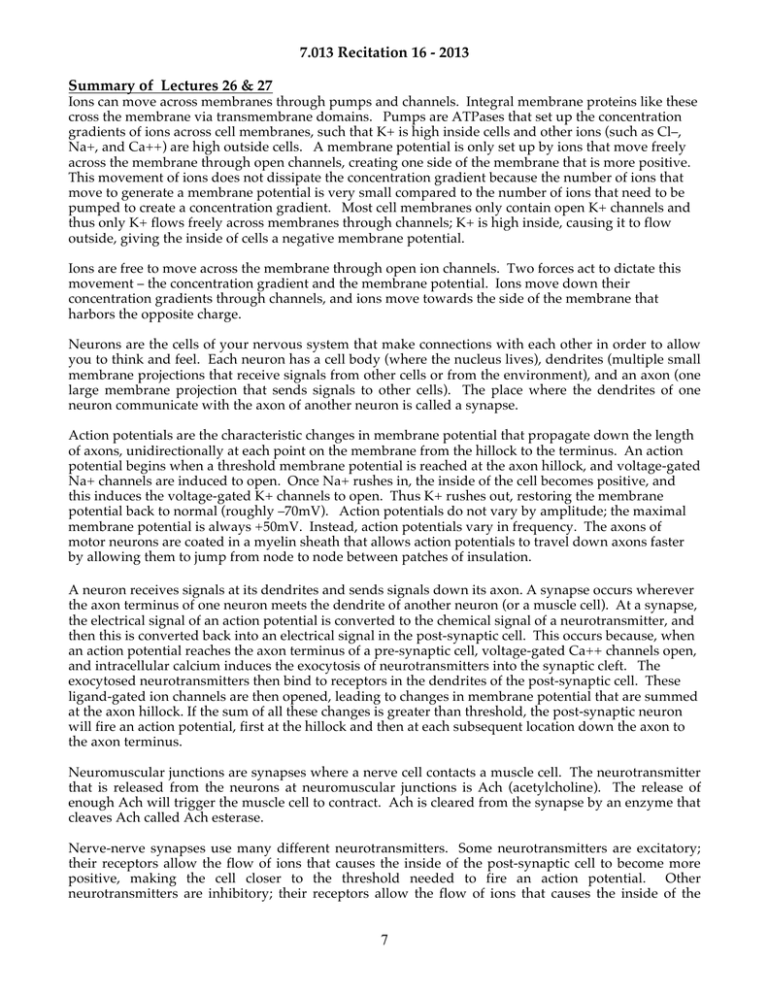
7.013 Recitation 16 - 2013 Summary of Lectures 26 & 27 Ions can move across membranes through pumps and channels. Integral membrane proteins like these cross the membrane via transmembrane domains. Pumps are ATPases that set up the concentration gradients of ions across cell membranes, such that K+ is high inside cells and other ions (such as Cl–, Na+, and Ca++) are high outside cells. A membrane potential is only set up by ions that move freely across the membrane through open channels, creating one side of the membrane that is more positive. This movement of ions does not dissipate the concentration gradient because the number of ions that move to generate a membrane potential is very small compared to the number of ions that need to be pumped to create a concentration gradient. Most cell membranes only contain open K+ channels and thus only K+ flows freely across membranes through channels; K+ is high inside, causing it to flow outside, giving the inside of cells a negative membrane potential. Ions are free to move across the membrane through open ion channels. Two forces act to dictate this movement – the concentration gradient and the membrane potential. Ions move down their concentration gradients through channels, and ions move towards the side of the membrane that harbors the opposite charge. Neurons are the cells of your nervous system that make connections with each other in order to allow you to think and feel. Each neuron has a cell body (where the nucleus lives), dendrites (multiple small membrane projections that receive signals from other cells or from the environment), and an axon (one large membrane projection that sends signals to other cells). The place where the dendrites of one neuron communicate with the axon of another neuron is called a synapse. Action potentials are the characteristic changes in membrane potential that propagate down the length of axons, unidirectionally at each point on the membrane from the hillock to the terminus. An action potential begins when a threshold membrane potential is reached at the axon hillock, and voltage-gated Na+ channels are induced to open. Once Na+ rushes in, the inside of the cell becomes positive, and this induces the voltage-gated K+ channels to open. Thus K+ rushes out, restoring the membrane potential back to normal (roughly –70mV). Action potentials do not vary by amplitude; the maximal membrane potential is always +50mV. Instead, action potentials vary in frequency. The axons of motor neurons are coated in a myelin sheath that allows action potentials to travel down axons faster by allowing them to jump from node to node between patches of insulation. A neuron receives signals at its dendrites and sends signals down its axon. A synapse occurs wherever the axon terminus of one neuron meets the dendrite of another neuron (or a muscle cell). At a synapse, the electrical signal of an action potential is converted to the chemical signal of a neurotransmitter, and then this is converted back into an electrical signal in the post-synaptic cell. This occurs because, when an action potential reaches the axon terminus of a pre-synaptic cell, voltage-gated Ca++ channels open, and intracellular calcium induces the exocytosis of neurotransmitters into the synaptic cleft. The exocytosed neurotransmitters then bind to receptors in the dendrites of the post-synaptic cell. These ligand-gated ion channels are then opened, leading to changes in membrane potential that are summed at the axon hillock. If the sum of all these changes is greater than threshold, the post-synaptic neuron will fire an action potential, first at the hillock and then at each subsequent location down the axon to the axon terminus. Neuromuscular junctions are synapses where a nerve cell contacts a muscle cell. The neurotransmitter that is released from the neurons at neuromuscular junctions is Ach (acetylcholine). The release of enough Ach will trigger the muscle cell to contract. Ach is cleared from the synapse by an enzyme that cleaves Ach called Ach esterase. Nerve-nerve synapses use many different neurotransmitters. Some neurotransmitters are excitatory; their receptors allow the flow of ions that causes the inside of the post-synaptic cell to become more positive, making the cell closer to the threshold needed to fire an action potential. Other neurotransmitters are inhibitory; their receptors allow the flow of ions that causes the inside of the 7 post-synaptic cell to become more negative, making the cell farther from the threshold needed to fire an action potential. There can be many, many inputs to a postsynaptic cell, and the summation of all of these inputs occurs across the cell body. If the excitatory inputs are sufficient to depolarize the membrane at the axon hillock, the voltage-gated Na+ channels at the axon hillock will open and an action potential will be generated. Two types of receptors can be found at a synpase: fast ionotropic receptors, which are ion channel receptors and the slower metabotropic receptors which indirectly activate channels. Questions: 1. Shown below is a plot of axonal membrane potential as a function of time, measured at a single position on the axon. C +50mV A -70mV B Time For each of the three time points indicated, fill in the following table. Name the phase of membrane potential that describes the time point, the channels/pumps that are involved, and explain how these channels/pumps maintain that phase. Time point Phase All the ion channel/ Pump involved Explanation A B C 2. Dopamine is one of major neurotransmitters in the mammalian brain that regulates mood, cognition and locomotion. Dopamine acts on two types of receptors: the D1 receptor is an inhibitory ligandgated channel, the D2 receptor activates the G proteins, and is excitatory. The released neurotransmitter is taken back into the presynaptic cell, for re-use. a) On what part of the neuron are the dopamine receptors localized? b) Is either D1 or D2 a metabotropic receptor? Explain. c) The D1 receptor is inhibitory and transports K+ ions. Would K+ be moved into or out of the postsynaptic cell? Explain the mechanism underlying this inhibitory effect. d) The D2 receptor is excitatory, and its ion targets are believed to include Ca2+. Would Ca2+ be moved into or out of the postsynaptic cell? Explain the mechanism underlying this excitatory effect. 8 MIT OpenCourseWare http://ocw.mit.edu 7.013 Introductory Biology Spring 2013 For information about citing these materials or our Terms of Use, visit: http://ocw.mit.edu/terms.

